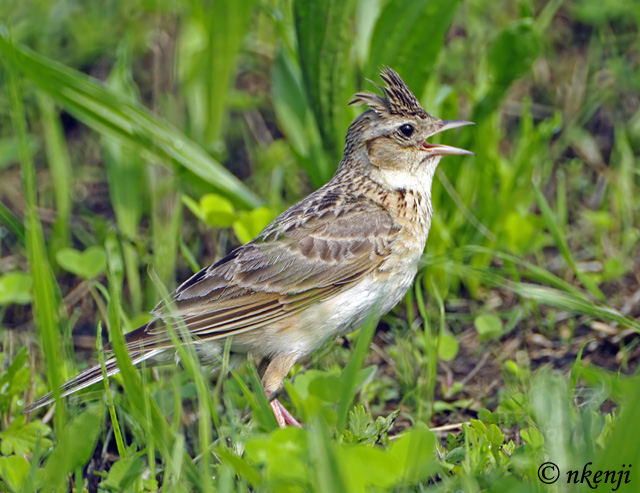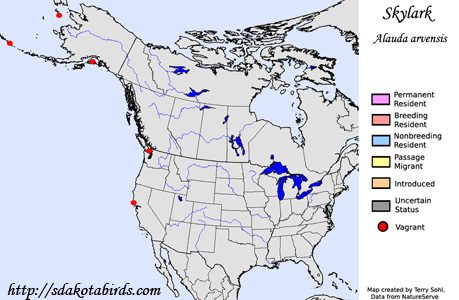| Length: 7.25 inches | Wingspan: 13 inches | Seasonality: Non-resident in South Dakota |
| ID Keys: Distinct, often raised crest, light-brown above with dark streaking, light below, white outer tail feathers | ||
 The
Eurasian Skylark is a species of Europe and Asia that has been introduced to many
other locations around the globe. In North America, many attempts were
made to introduce the species in the 19th century, but the only surviving
population with breeding was on southern Vancouver Island in Canada.
Small numbers of Eurasian Skylarks continue to be found on Vancouver Island and
nearby San Juan Island of Washington State, but the small population has
been declining. Eurasian Skylarks are also introduced in Hawaii, where they are
relatively common. Elsewhere in North America, Eurasian Skylarks are considered
casual visitors in the western Aleutian Islands in Alaska, as well as on
islands in the Bering Sea. There are some indications that Skylarks
may occasionally breed in the Pribilof Islands in the Bering Sea.
Sightings of the species have also rarely occurred away from western Alaska
or the Vancouver population, including an accepted sighting at Point Reyes
in California in 1978.
The
Eurasian Skylark is a species of Europe and Asia that has been introduced to many
other locations around the globe. In North America, many attempts were
made to introduce the species in the 19th century, but the only surviving
population with breeding was on southern Vancouver Island in Canada.
Small numbers of Eurasian Skylarks continue to be found on Vancouver Island and
nearby San Juan Island of Washington State, but the small population has
been declining. Eurasian Skylarks are also introduced in Hawaii, where they are
relatively common. Elsewhere in North America, Eurasian Skylarks are considered
casual visitors in the western Aleutian Islands in Alaska, as well as on
islands in the Bering Sea. There are some indications that Skylarks
may occasionally breed in the Pribilof Islands in the Bering Sea.
Sightings of the species have also rarely occurred away from western Alaska
or the Vancouver population, including an accepted sighting at Point Reyes
in California in 1978.
Habitat: The small introduced population on Vancouver Island is found in open grassy areas. In their native Eurasian range, they are found in a variety of open habitats, including grasslands and steppes, farmland, and wetland edges.
Diet: Feeds on seeds, insects, and spiders.
Behavior: Eurasian Skylarks mostly forage by walking along in open habitats, picking up seeds and insects from the ground, or from the foliage and seed heads of low vegetation.
Nesting: The nest of a Eurasian Skylark is constructed on the ground in a grassy area. The nest itself is a depression lined with grasses and roots. The females lays between 3 and 5 eggs, and she alone incubates them. After the eggs hatch, both parents help to feed the young, who leave the nest after about 10 days.
Song: Song is a series of musical, liquid warbling notes, given during spectacular display flights for which the species is well known.
Migration: Eurasian Skylarks hanging on around Vancouver Island are considered permanent residents. In their normal Eurasian range, birds breeding in the north are migratory, while some populations further south in Eurasia are considered permanent residents.
Interactive eBird map: Click here to access an interactive eBird map of Eurasian Skylark sightings
Similar Species: In North America, the only other member of the Lark family is the Horned Lark. While similar in structure and size, plumage differences between the two species are obvious. In North America, perhaps the two species most likely to be confused with the Eurasian Skylark are the American Pipit or the Lapland Longspur.
Conservation Status: In their normal Eurasian range, populations are widespread and strong, although there are signs of declines in recent decades. The IUCN lists the Eurasian Skylark as a species of "Least Concern". The small introduced population around Vancouver Island has been in decline.
Further Information: 1) BirdWeb - Skylark
2) British Garden Birds - Skylark
3) British Trust for Ornithology - Skylark
Photo Information: Photo taken by Ken (nkenji) - Photo licensed under Creative Commons Attribution NonCommercial NoDerivs 2.0 Generic License.
| Click below for a higher-resolution map |
 |
| South Dakota Status: Non-resident in South Dakota |
Additional Skylark Photos (coming soon!!)
